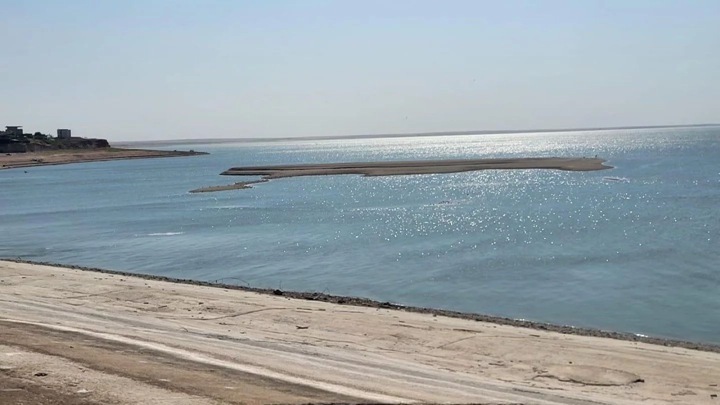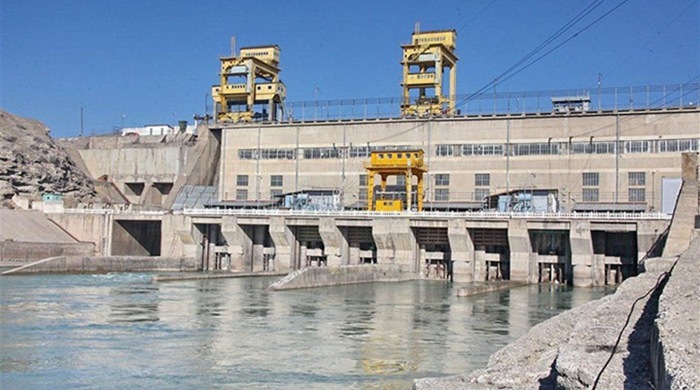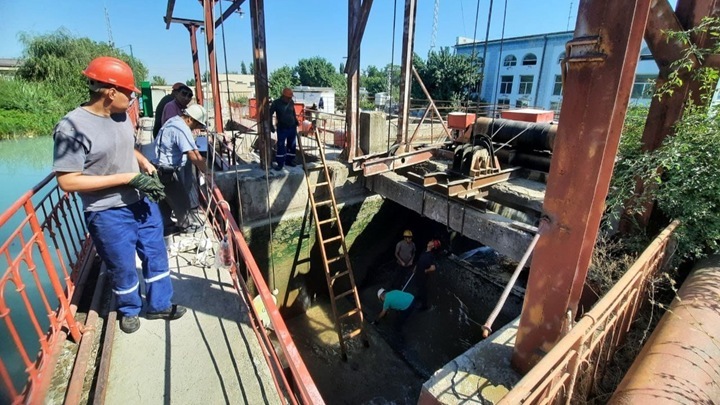Why did the Shardara reservoir turn out to be on the verge of devastation?
The main water reserve of the region was on the verge of devastation. The Shardara reservoir in Kazakhstan provides drinking water to 32 thousand residents of the city and provides water for irrigation of farmland in the Turkestan and Kyzylorda regions. But now this strategic facility is in critical condition, and the problem is not only in nature, but also in the decisions that people make, the newspaper reports. Orda.kz:

How it all started
At the beginning of 2025, the situation at the Shardara reservoir looked relatively safe. The volume of water was 4.4 billion cubic meters, which is even more than a year earlier, when the region was already facing a shortage of resources. According to experts’ calculations, with proper management and coordinated operation of hydraulic structures, up to 5.2 billion cubic meters could be accumulated by the beginning of the irrigation season. Such a reserve would allow to pass spring and summer without serious interruptions even in conditions of reduced inflow.
However, by April, when mass watering began, only 4.5 billion cubic meters of water turned out to be in storage. Already at the start, the region missed about 700 million cubic meters — a volume that would be enough to fully irrigate tens of thousands of hectares of fields or provide water to large cities for several months.
This was the first alarm signal that the upcoming season will be tense and could turn into a serious deficit.
By the end of April, the water level had dropped to critical values — only 15% of the total capacity of the reservoir. The reasons became clear after studying the documents and minutes of the meetings of the Interstate Water Management Commission.
Discharges in excess of agreements
On April 5, 2025, a meeting of the Interstate Coordination Water Management Commission (ICWC) was held, where they distributed how much water each country would receive from the Syr Darya and Amu Darya rivers during this growing season. Kazakhstan was allocated only 909 million cubic meters of Syr Darya through the Dustlik channel. For comparison:
- Uzbekistan — 8.8 billion cubic meters,
- Tajikistan — 1.9 billion,
- Kyrgyzstan — 270 million.
Then it was predicted that about 3.1–3.6 billion cubic meters of water would come to the Shardara reservoir during the season. These figures formed the basis of the distribution. But in the summer it turned out that the real inflow was less than expected. As a result, there is not enough water even to maintain the normal level of the reservoir, not to mention the full provision of agricultural fields and household needs.
At the beginning of the year, the inflow was more than a thousand cubic meters per second, in February — 900, and in March – 500. But since April 19, the figures began to fall — first to 320, then to 73 cubic meters per second. In July, the reservoir received only 42 cubic meters per second, and in June — 31 at all. In fact, the water has stopped reaching Shardara.
Now the shortage of water has become noticeable: there are interruptions in the agricultural areas of the Turkestan region, and in Shardara itself. For the city, this is a double blow — less water is supplied both for household needs and for the Shardarinskaya HPP, which affects both the energy sector and the condition of the fish in the reservoir.
The ICWC’s spring decisions, adopted under optimistic forecasts, have actually aggravated the situation today. In addition, the lack of runoff and the redistribution of water according to approved limits is already affecting the situation in Kyzylorda. There, the shallowing of the Syr Darya and a decrease in water supply threaten both agriculture and the provision of the population. If the current rates of water supply are maintained, the risks for the region will only grow.
Illegal water intake
At least seven pumping units operating without permits have been identified on the 15-kilometer section of the Syrdarya River from the hydropost to the Shardara reservoir. These pumps pumped water, bypassing the accounting and official limits set for the distribution of water resources. According to experts, only these unauthorized intakes could take tens of millions of cubic meters per season.
To understand the scale: this volume is enough to provide water to several districts during peak irrigation or to fill part of the deficit that has arisen in the Kyzylorda region. The problem lies not only in the illegality of the selection itself, but also in the fact that such pumping was carried out in conditions of an already critically low inflow into the reservoir. Every cubic meter that went through illegal pumps directly reduced the supply of water in the Shardar and reduced the chances of maintaining a stable supply to the canals feeding farmland and settlements downstream.
Rice fields despite prohibitions
In conditions of acute water shortage, the Ministry of Agriculture at the beginning of the season recommended regions to limit the area of moisture-loving crops, especially rice. Watering one hectare of this crop requires several times more water than for most other agricultural plants, and in a low-water year such crops become an unaffordable luxury.
Despite this, in the Turkestan region, the plan for rice crops was exceeded twice: instead of the planned 6.6 thousand hectares, 13.1 thousand hectares were sown. More than a thousand contracts for water supply — a total of 1,032 — were concluded without approval from the akimat. After receiving contracts from the RSE “Kazvodkhoz”, the peasants were confident that their farms would be provided with irrigation water for the whole season, and began to plant rice actively. Many farmers admit that if there were no such agreements, they would choose less moisture-loving crops, which would significantly reduce the load on the Shardara reservoir and canals.
It is important to note that the RSE “Kazvodkhoz” is under the jurisdiction of the Ministry of Water Resources and Irrigation of the Republic of Kazakhstan, and the Shardara reservoir itself is under their management. It is this department that determines the order of water distribution, its tributaries and discharges, and also decides which volumes are directed to irrigation needs, and which to other regions or reservoirs.
In terms of districts, the situation looked like this:
- Maktaaral district — 5178 hectares,
- Zhetysaysky district — 1518 hectares,
- Shardara district — 6453 hectares.
Such an increase in crops in low-water conditions additionally loaded the Shardara reservoir and the canals leading to the Kyzylorda region. If in normal years an excess of water could compensate for overspending, then in 2025 every extra thousand hectares of rice meant millions of cubic meters that other crops and settlements lost. As a result, rice massifs received priority in the allocation of resources, and other farms and villages began to feel an acute shortage of water.
The critical situation in August
As of August 13, only 232 million cubic meters of water remained in the Shardara reservoir — 1.127 billion less than the planned level. The vacation limit for the Kyzylkum main canal is almost exhausted — 95% has already been given. The irrigation of seven thousand hectares of cotton and two thousand hectares of rice, as well as the uninterrupted supply of drinking water to tens of thousands of residents, was under threat.
And more than 10 species of commercial fish live in the Shardara reservoir. The total ichthyomass is about 10.8 thousand tons. If the water level drops below 200 million cubic meters, mass extinction of about two thousand tons of fish is possible. Such a blow to the ecosystem will lead to the suspension of fishing for at least five years — that’s how long it will take to restore stocks and spawning conditions. Planned stocking has already been suspended — in 2025 it was planned to release 740 thousand fry, but the work has been frozen. The survival rate of fry in natural conditions is only 10%, so losses will be irreparable in the short term.
The Shardara HPP provides electricity to a significant part of the south of Kazakhstan, including rural areas of the Turkestan region and part of Shymkent. At normal water levels, the station produces over 100 megawatts, which is enough for a stable supply of hundreds of thousands of residents. But with a critical drop in the water level, which is already being observed, the generation can collapse several times — to values at which the station can barely support the operation of the systems. In this case, there will be enough energy only to cover the station’s own needs and minimal supply to the network.
The origins of the disaster
This is the result of not only natural factors, such as drought and abnormal heat, but also management errors. Excess water discharges, illegal pumps and the doubling of rice crops in conditions of shortage have all led the region to a water crisis. If emergency measures are not taken and strict control over the use of water is introduced, Shardara risks meeting autumn with minimal reserves and a real threat of a socio-economic crisis.
The situation with the water supply and operation of the Shardara reservoir raises many questions that require clarification from the Ministry of Water Resources and Irrigation. We are talking about both the distribution and use of water resources and the management decisions made in conditions of low water. We will send an official request to the department in the near future.
Alexandra Kim (Orda.kz )
Original (in Russian): Почему Шардаринское водохранилище оказалось на грани опустошения?


